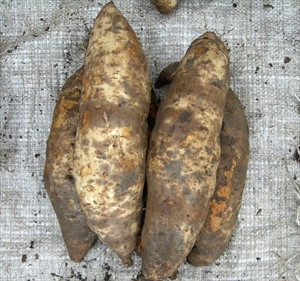Sweetpotato scurf
Pacific Pests, Pathogens, Weeds & Pesticides - Online edition
Pacific Pests, Pathogens, Weeds & Pesticides
Sweetpotato scurf (260)
Monilochaetes infuscans
Asia, Africa, North (Hawaii), South America, Europe, Oceania. It is recorded from Cook Islands, Federated States of Micronesia, New Zealand, Northern Mariana Islands, Palau, Papua New Guinea, Tonga, and Vanuatu.
Sweetpotato, and wild Ipomoea species.
A fungus causes the disease. Greyish spots and patches (these may be purplish-brown to black on orange fleshed varieties) occur, with irregular margins, joining together and often covering most of the storage roots (Photos 1&2). The colour of the infections depends on the variety. However, the infections are only in the 'periderm' of the storage roots; this is the thin 'skin' outside the starchy flesh. Spores are produced on the surface of the infected spots and patches.
Spots, similar to those on the storage roots, may occur on the stems and leaves if infected storage roots are used as a source of planting material.
The fungus is worse in soils with high organic matter, and much less in light sandy soils. Also, scurf is worse during rainy seasons. Spread occurs on infected cuttings, and these can be a source of spores to infect the storage roots. Survival occurs in crop debris for 2-3 years.
Scurf is a 'cosmetic' disease, meaning it does not reduce the yield of the storage roots or their taste, but it affects their appearance, which could mean a lower price in the market.
Look for greyish spots and patches on the storage roots; they are especially noticeable on white skinned varieties. They are darker on orange-fleshed varieties (Photo 2).
CULTURAL CONTROL
The following will help to reduce the amount of infection:
Before planting:
- Use a crop rotation of 2-3 years for sandy loam soils - longer (3-4 years) for soils high in organic matter.
- Remove wild Ipomoea weeds, i.e. those belonging to the morning glory family.
- Make sure cuttings for planting are free from infection: (i) take cuttings only from plants whose storage roots were free from symptoms at harvest; (ii) if using storage roots to grow sprouts for planting, choose only those free from symptoms of scurf. It is easier to see symptoms if the storage roots are wet. Cut spouts (also called 'slips') 2-3 cm above soil level to avoid carrying the fungus to the field.
- Use land free from the scurf fungus, i.e. land where previous harvests of storage roots have been free from symptoms.
- Do not add organic manures to soil where scurf symptoms occur on storage roots.
After harvest:
- Remove harvested vines and burn them. Do not incorporate into the soil.
RESISTANT VARIETIES
There are no varieties that are resistant to the fungus. Varieties that form storage roots lower in the soil may have less infection because they are further from the source of spores.
CHEMICAL CONTROL
There are no fungicides that can be used to manage this disease.
AUTHOR Grahame Jackson
Information from CABI (2015) Monilochaetes infuscans (scurf of sweet potato). Crop Protection Compendium. (https://www.cabi.org/cpc/datasheet/34723); and Monilochaetes infuscans (MNLCIN). EPPO Global Database. (https://gd.eppo.int/taxon/MNLCIN); and from Ekman J, Lovatt J (2015) Pests, Diseases and Disorders of Sweetpotato: A Field Identification Guide. (https://www.soilwealth.com.au/imagesDB/news/Sweet-Potato-Pest-and-Disease-Guide.pdf).
Produced with support from the Australian Centre for International Agricultural Research under project PC/2010/090: Strengthening integrated crop management research in the Pacific Islands in support of sustainable intensification of high-value crop production, implemented by the University of Queensland and the Secretariat of the Pacific Community.





